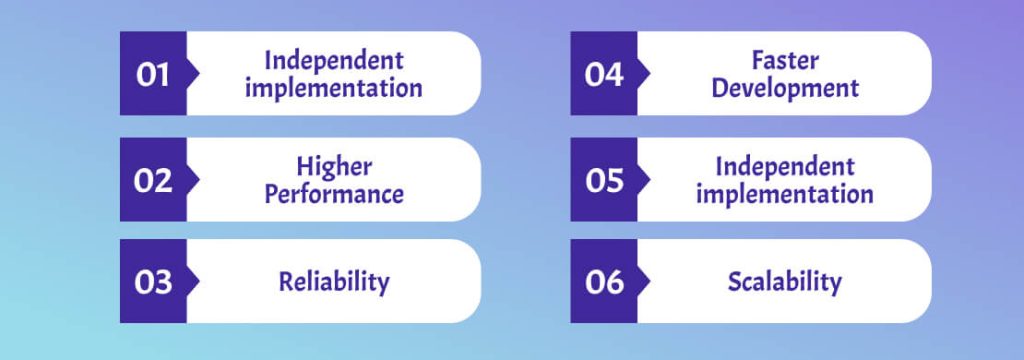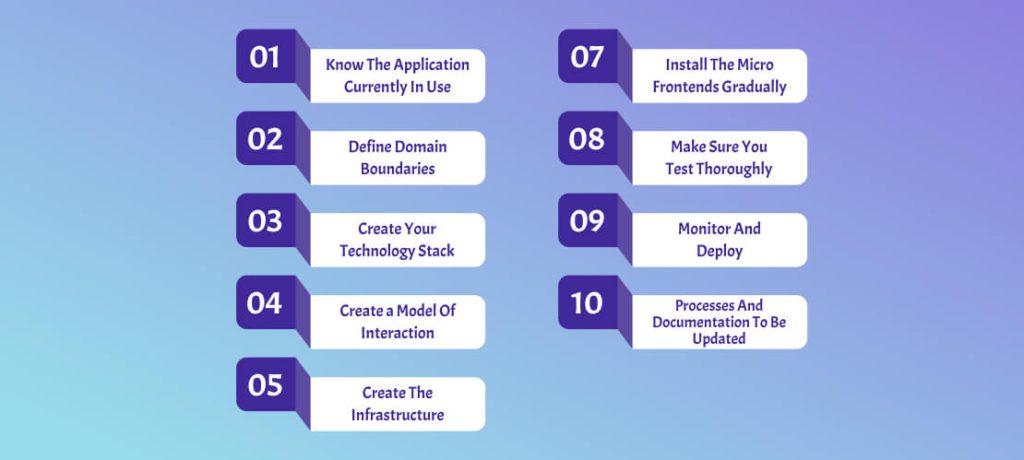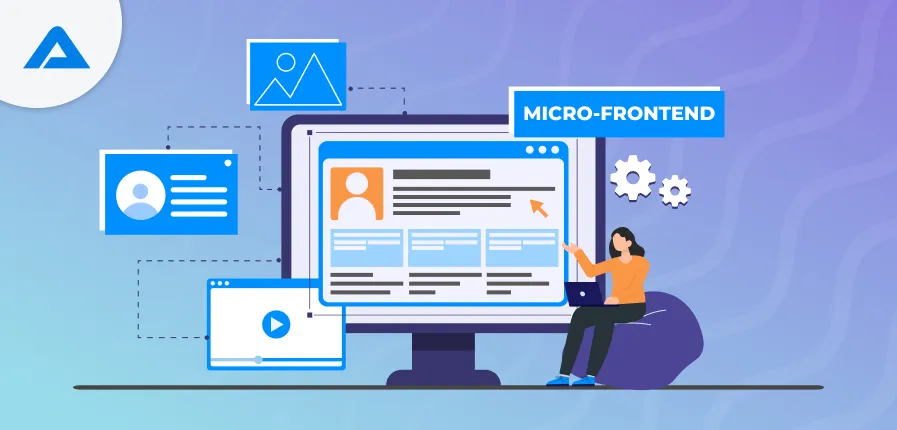In today’s fast-paced web design environment, making user-friendly and high-quality web applications is an absolute priority. As applications become more complicated, conventional development methods have encountered challenges. The solution is ” Micro Frontends Architecture,” which provides speed and flexibility for frontends of web-based applications.
With the development of new web applications, the front end becomes more extensive and more complex, while the back end becomes less crucial. The conventional monolithic development method isn’t working in these massive applications since it’s challenging to manage. Therefore, in the spirit of the microservices concept, micro frontends provide the best solution for modern, complicated web applications. They allow the app to be broken down into small, independent modules.
This blog post will examine micro frontends, their fundamental concepts, the different types of existing micro frontends, and more. Knowing micro frontends could bring your web development projects to a new level of flexibility and efficacy. Therefore, let’s dive in!
Understanding Micro Frontends
Micro frontends are separate, self-contained modules (or an application in itself) responsible for a particular element of the user’s interface (UI) within an online application. They were developed to expand the microservices framework used in the backend. This framework focuses on reducing the monolithic application into manageable, more minor, easily managed components. Like micro frontends, the UI is broken down into small components or modules developed, implemented, deployed, and managed separately. Each module will typically be assigned a specific job function.

Experience the Difference: Try Our Proven Frontend Solutions Now!

Pooja Upadhyay
Director Of People Operations & Client Relations
The micro frontend was designed to solve the problems of massive and complex web applications, such as collaboration between development teams, versioning issues, and the requirement for regular changes. The micro frontend framework enables modularity, scaling, and selection flexibility by breaking down the front end into smaller pieces divided by their group.
Micro frontends include:
- The user interface is split into smaller pieces of granular material rather than forming a single monolith.
- Each micro frontend functions as an independent unit, with its database, codebase, and logic
- Various micro frontends are created using multiple technologies, programming languages, and frameworks.
- Updates or modifications to a module are not required to redeploy all the modules in the application.
- Micro frontends interact via clearly defined APIs or interfaces. This ensures that changes to one component do not cause unwanted effects on other modules.
- Micro frontends applications typically permit users to have a personalized experience. These modules can be tailored to individual users’ unique requirements.
- Since changes are restricted to specific modules, updates can be made incrementally, which reduces the possibility of creating bugs and improves stability overall.
- Problems or malfunctions within one frontend micro aren’t likely to affect the overall system since each module is distinct.
We now know what micro frontends are. Let’s examine the benefits this design approach can provide.
What Is The Function Of Micro Frontends?
A micro frontend could be an entire page or specific fragments from the page that different teams could utilize to include in the web page they’re creating. Contrary to reusable components, micro frontends can be developed in separate projects. Methods for creating micro frontends include :
- Developing each component separately,
- Extracting the additional components during runtime,
- Making them available for use.
The micro front consists of various modular and independent elements that can be displayed according to the requirements. This means that for any webpage, only the components required for the page are loaded. Micro frontends interact directly with data and do not depend on a central server to process requests or information. Apart from components for displaying information, a micro frontend could also include various utility components that connect to the user’s environment, including an individual user or any other component.
Benefits Of Micro Frontends

Micro frontends have a wealth of benefits that overcome the weaknesses of monolithic solutions and aid in achieving an efficient and durable developing process.
Independent implementation
Micro frontends allow developers to function independently, just as specialized artisans within the collaborative workshop. The teams are free to design their architecture according to the specific modules they work in. This independence spurs imagination and encourages creativity by allowing teams to select methods and technologies that suit their particular task.
Micro frontends can reduce team dependence, slowing the development of monolithic programs. Teams can make decisions quickly and adjust to changing demands without being impeded by the central authority.
Higher Performance
Monolithic applications generally load the whole codebase comprising components users may only need after some time. Micro frontends, on the other hand, load modules in a specific order. Optimized loading reduces the loading time for initial loads, leading to an improved and speedier user experience. By loading only essential elements, micro frontends cut down on resource consumption and boost the performance of all Web Application Development Services.
Faster Development
Micro frontends’ independence results in faster development times. Modifications or enhancements to an individual module or function don’t require the re-implementation of a whole application. Teams can iterate and publish changes independently, leading to faster development cycles. Self-contained, smaller modules are easier to maintain. Developers can concentrate on the micro-frontend when issues or upgrades need to be made without impacting the overall applications.
Reliability
Micro frontends provide a solid and fault-tolerant design. The application will function seamlessly if one module has problems or requires repair. This is crucially important in big-scale apps that require many distinct features—micro frontends’ reliability results in a better user experience. Users can use non-affected areas of the software regardless of whether some modules are in the process of updating or maintenance.
Scalability
Micro frontends allow scalability at the module level. If specific application components are subject to increased demands, it is possible to scale these modules independently, creating the most responsive and practical user experience. Micro frontends are easy to use if your project expands by adding more team members or resources. Each team can be in charge of one specific module, ensuring the system can proliferate in line with ever-changing needs.
When To Choose Micro Frontend Architecture
Micro frontend architecture has strengths and weaknesses, implying that you must balance your tasks when using the type of architecture you select. Here, we will outline situations where micro frontends can offer your desired advantages.
In The Process Of Building Enterprise-Level Applications
Micro-frontend architecture best suits big applications, whether proliferating or more complex. If multiple people are involved in your Front-End Development, changing to micro-frontends can make your implementation more flexible. This type of architecture can help eliminate bottlenecks and blocks.
If You Require An Independent Deployment
Micro frontends are very effective for independent implementations when they are the main focus. Micro frontends could be ideal if you update your software frequently but without interruption (disrupting the whole application).
Modularity makes it easy to alter, test, and implement different parts without disrupting the function of other program components. This structure is well-suited to rapidly moving environments that also need agility. Choose micro frontends if you need to adapt quickly to changes in marketing needs.
If You Are Working With Various Technologies
If your app is created by several teams that utilize different technology stacks, Micro frontend architecture can precisely meet those teams’ requirements. Every team working on a separate module can choose the stack that best suits their needs, including different software, frameworks, and libraries. Micro frontend architecture can allow diverse components of an application to work together even though they rely on entirely different technologies.
To Limit Your Risk Of Failing
This is precisely what you need! Micro frontend architecture provides the ideal foundation for creating modern applications because it helps reduce the likelihood of the application failing (and it is well known that this is one of the main reasons for losing customers). Micro frontend architecture allows you to decouple or untangle various parts of an application to ensure that other elements still operate should something go wrong with one.
In The Case Of Working With Many Team Members Who Are Separate From Each Other
Modern software is rarely created by one team of developers. Many complex projects need the collaboration of multiple teams who bring their knowledge to various components. Micro frontend architecture is perfectly compatible with such collaboration scenarios and supports collaboration among multiple distinct teams in the same application.

You Want To Design An App That Can Be Adapted To Your Needs
If you’re looking to build products customized to suit different kinds of users, the micro-frontend structure is an ideal choice. Consider the Uber application, for example. It is a singular micro-frontend with two distinct apps for passengers and drivers. Each one is equipped with particular functions for each of the respective users. This structure allows users to create a single product that is customized and configured in many ways, helping keep the design consistent.
If You Are Looking To Upgrade Your Current Solution Slowly
Micro-frontends were designed to facilitate the transfer and integration of older applications. They were designed to allow the slow replacement of the older components by micro-frontends so that companies could upgrade their software without needing a complete overhaul. Therefore, this design can be used to modernize the existing solutions.
When Not To Go With Micro-Frontends
In the past, creating a micro-frontend framework could satisfy your business’s needs and avoid potential problems, so weighing every aspect of benefits and drawbacks is essential. Consider the risk you need to consider when you consider the following scenarios. If you are still looking for a skilled engineer to work with you, look for a software engineering partner.
The Micro frontend frameworks are complex. Therefore, creating efficient solutions using this model requires knowledge and experience. The results could be severe if someone isn’t sure how to implement the framework. The application must be adaptable, which is not often easy to accomplish. If you opt for this kind of structure, ensure that you collaborate with an implementation company that has extensive experience in this kind of structure. If the application is not built correctly, it could create highly intertwined parts. If multiple parts are linked, breaking them apart when adding new elements can complicate the design process and slow development.
What Is The Best Way To Move Your Application Onto Micro Frontend Technology?

The migration process requires breaking down the monolithic front into several independent functionally cohesive modules that can be designed, implemented in various ways, and scaled separately. The aim is to build more flexible, adaptable, and maintainable software. Below is a step-by-step guide to assist you in the procedure:
Know The Application Currently In Use
Before starting the migration process, it is essential to be ready by thoroughly analyzing the current infrastructure, including the dependencies and information flows. Examine the stack of the technology behind it and explore its features. This is necessary to comprehend the problems arising from the migration process and devise strategies to address them effectively.
Define Domain Boundaries
In the past, we have mentioned that, generally, every micro frontend is accountable for a particular business purpose of the app. In this phase, you’ll be required to split your app into distinct business domains. Therefore, the used micro frontends encapsulate an element of the functions and allow the frontends to function independently. This micro frontend design expands the Microservices Architecture idea to the backend by isolating the components. This ignites them to a specific domain business domain and eliminates cross-domain interference.
Create Your Technology Stack
Choosing the best technology stack is crucial for successfully developing micro frontend technology. Select the tech stacks you want to utilize, but remember to select different ones for each micro front end. You must also maintain an evenness and ability to deal with complex issues. Making a shared library of components containing all the standard UI components could help keep the required consistency while eliminating duplicates and version conflicts.
Create a Model Of Interaction
A crucial step to an effective transition from micro frontends is to create an effective interaction model that ensures uninterrupted communication between them and the app’s backend. The right approach must be adopted to minimize the direct dependency between micro frontends and maintain their individuality by not allowing interdependence.
Create The Infrastructure
Before implementing, it’s also essential to set the foundation of your micro frontend’s architecture. It will serve as the foundation of the code upon which micro frontends can be constructed. It is crucial to wrap functionalities in. Encapsulation is an essential and efficient method to avoid the domino effect of component failure. This technique helps ensure that if one application component is damaged, it’s the sole component that fails.
Install The Micro Frontends Gradually
Moving gradually is a good approach for transitioning from monolith to micro frontend architecture. Begin with the most minor and most important parts of your application. This allows you to observe what happens to your application as you adapt to the new design and to quickly resolve any issues that occur (much more easily than if you were starting with the more essential elements). As such, this process should help improve processes, anticipate potential issues, and refine strategies before dealing with more intricate micro frontends.
Make Sure You Test Thoroughly
This crucial step ensures security and compatibility with your micro-frontends. While your team members work with their micro-frontends, subject everyone to rigorous tests. Find out the specific instances in which missing data from one of the micro-frontends affects the performance of a different one. It is essential to find potential bottlenecks or hidden dependencies that could affect the user experience so that you can eliminate them.
Monitor And Deploy
Micro frontends require a great focus on performance, security, and reliability. If a micro frontend is successful in the tests, it can be deployed to your production environment, and then you can observe its performance. It’s essential to spot issues and anomalies promptly (or immediately after they arise) for a smooth user experience. Sometimes, you may need to bring back the deployment of severe problems.
Implementing the appropriate CI/CD pipelines and methods for versioning can help simplify this process. It’s crucial to have a proper implementation compatible with other micro frontends and established standards, as using micro frontends could make this process complex and lengthy.
Processes And Documentation To Be Updated
Documentation is a common practice when working on any software development project. It outlines the entire procedure and ensures it’s kept updated daily. It is essential, mainly if your system evolves, and it informs your employees of any possible modifications. Thorough documentation will help you smoothly transition into the micro front when you begin to roll out future deployments.
The steps above should assist you in quickly navigating the transition from a monolithic app to a micro frontend.
Conclusion
Micro frontends are a trend that represents a significant transformation in web development to meet the ever-changing requirements of contemporary applications. Modular frontend designs allow developers to collaborate independently, encouraging innovation and flexibility. By breaking complex software into modules with self-contained components, Micro frontends provide benefits like faster development times, optimized performance, and increased performance.
As the need for responsive and flexible web-based applications grows and evolves, micro frontends remain on the cutting edge of innovation in architecture. Adopting micro frontends will revolutionize the development of web applications when dealing with a huge-scale project that includes multiple functions or hopes to be agile with ever-changing requirements. When embarking on your next web development adventure, consider the potential of micro frontends for creating functionality.

Enhance Your Digital Presence: Hire a Top-notch Frontend Developer Now!

Pooja Upadhyay
Director Of People Operations & Client Relations

